Hemiramphidae is a family of fishes that are commonly called halfbeaks, spipe fish or spipefish. They are a geographically widespread and numerically abundant family of epipelagic fish inhabiting warm waters around the world. The halfbeaks are named for their distinctive jaws, in which the lower jaws are significantly longer than the upper jaws. The similar viviparous halfbeaks have often been included in this family.
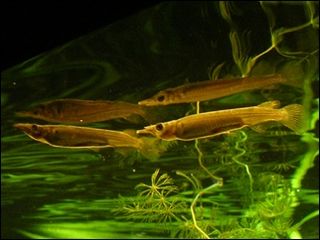
The wrestling halfbeak also known as Malayan halfbeak is a species of viviparous halfbeak native to the fresh and brackish waters of rivers and coastal regions in South-East Asia, in Singapore, Thailand, Indonesia, Thailand, Malaysia, Borneo and Sumatra. It is a small, slender, livebearing fish, with the elongated lower jaw characteristic of its family. The colour of this species varies, depending on where the specimen is found. It is the type species of the genus Dermogenys.
The ballyhoo halfbeak or ballyhoo is a baitfish of the halfbeak family (Hemiramphidae). It is similar to the Balao halfbeak in most features. Ballyhoo are frequently used as cut bait and for trolling purposes by saltwater sportsmen. The fish is reported to have caused ciguatera poisoning in humans.
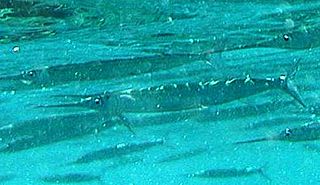
Hemiramphus is a genus of schooling marine fish commonly called halfbeaks, garfish, or ballyhoos, and are members of the family Hemiramphidae. They inhabit the surface of warm temperate and tropical sea, and feed on algae, plankton, and smaller fish. Hemiramphus species are edible but are more important as food fish for larger predatory species including dolphinfish and billfish.
Chriodorus atherinoides is a species of halfbeak found in coastal waters of the western Atlantic Ocean from southern United States to Mexico including Cuba and the Bahamas. This species is euryhaline and frequently migrates up rivers. It is of no commercial value. Unlike most other halfbeaks, the upper and lower jaws are of a similar size.
Nomorhamphus megarrhamphus is a species of viviparous halfbeak, a freshwater fish endemic to Lake Towuti in Sulawesi, Indonesia.
The Poso halfbeak is a species of viviparous halfbeak endemic to Lake Poso and its tributaries in Sulawesi, Indonesia.
Tondanichthys kottelati is a species of viviparous halfbeak endemic to Indonesia, where it is only known from Lake Tondano near Mount Tondano in the far north of the island of Sulawesi. It grows to a length of 6.4 centimetres (2.5 in) SL. Despite being a member of the viviparous halfbeak family, this species is believed to be oviparous. This species was described in 1995 by Bruce Baden Collette and its species name honours the Swiss ichthyologist Maurice Kottelat.
The Philippine snubnose halfbeak is a species of halfbeak. It is a coastal species that originates from the South China and Sulu Seas around the Philippines and Malaysia. It grows to about 22.7 centimetres (8.9 in) SL. It is the only member of its monotypic genus and was originally described as Oxyporhamphus brevis by Alvin Seale in 1910 with the type locality given as Paawacan, Palawan Island, Philippines.

Euleptorhamphus is a genus of halfbeaks in the order Beloniformes.

The Balao halfbeak, occasionally called the Balao for short, is an ocean-going species of fish in the family Hemiramphidae. It was first described by the French naturalist Charles Alexandre Lesueur in 1821. They are used as cut bait and for trolling purposes by saltwater sportsmen.
Enneapterygius similis, known commonly as the black and red triplefin, blacktail triplefin or masked threefin, is a species of triplefin blenny in the genus Enneapterygius. It was described by Ronald Fricke in 1997. This species occurs in the western central Pacific Ocean, from the Ryukyu Islands south through the Philippines, in Sabah, central Indonesia, Shepard Island, New Caledonia and eastern Australia.
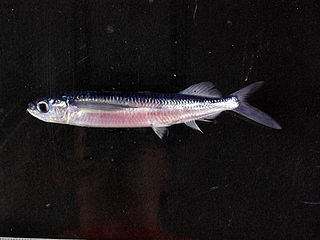
Oxyporhamphus is a genus of halfbeaks from the family Hemiramphidae. This genus contains two species, one in the warmer waters of the Atlantic and the other in the Indo-Pacific region.
Rhynchorhamphus georgii or long-billed halfbeak is a halfbeak of the family Hemiramphidae of the order Beloniformes.

The American halfbeak, also known as Meek's halfbeak, is a halfbeak from the family Hemiramphidae.
The Congaturi halfbeak, also known as the Valenciennes halfbeak, is a potamodromous species of fish in the family Hemiramphidae. It is a valued commercial fish in tropical countries both dried salted and fresh forms.
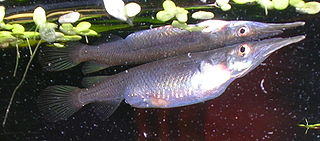
Zenarchopteridae, the viviparous halfbeaks, is a family in the order Beloniformes. The Zenarchopteridae exhibit strong sexual dimorphism, practicing internal fertilisation, and in some cases ovoviviparous or viviparous. The members in the family are mainly found in fresh and brackish water of tropical Asia and New Guinea, but the genus Zenarchopterus also includes marine species from the Indo-Pacific. Several, such as the wrestling halfbeak, have become commonly traded aquarium fish.

The longnose killifish is a marine tropical benthopelagic fish of the genus Fundulus and the family Fundulidae. It is endemic to the western Atlantic Ocean, ranging from along the coast of the Gulf of Mexico from the Florida Keys to Tampico in Mexico. It can grow up to 12 centimeters in length. The body is rounded, elongate, and olive to silver colored with dark vertical stripes. It can be distinguished from other killifish by its long snout and a dark spot on last vertical bar. This species requires to be allocated a new binomial as Fundulus similis is preoccupied by a junior synonym of Fundulus majalis, the name having been given to a Gulf of Mexico population of that species.
The feathered river garfish, also known as the estuarine halfbeak, spoon-fin garfish, spoon-fin river garfish and viviparous half beak, is a species of marine, freshwater, brackish and reef-associated oceanodromous viviparous halfbeak found in Indo-Pacific regional countries, such as Kenya, Mozambique, Seychelles, Madagascar, New Guinea, Solomon Islands, Australia, New Caledonia, Fiji, Sri Lanka, India, Vanuatu, Malaysia, Thailand, Singapore and Samoa.
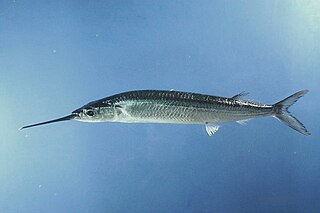
Hyporhamphus unifasciatus, the common halfbeak or the Atlantic silverstripe halfbeak, is a bony fish in the family Hemiramphidae. It is found in the subtropical western Atlantic Ocean and the Gulf of Mexico. It is a common fish and not used for food to any great extent, and the International Union for Conservation of Nature has listed its conservation status as being of "least concern".









